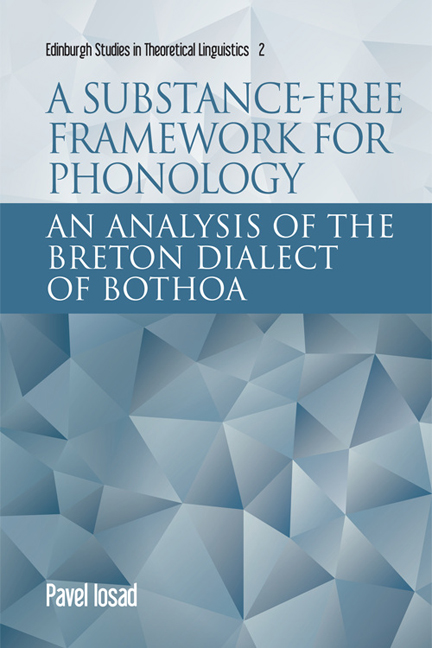Book contents
- Frontmatter
- Contents
- Acknowledgements
- Chapter 1 Introduction
- Chapter 2 Conceptual foundations of substance-free phonology
- Chapter 3 Representational assumptions
- Chapter 4 Computational assumptions
- Chapter 5 Complexity and markedness in substance-free phonology
- Chapter 6 The Breton language
- Chapter 7 Segments and representations
- Chapter 8 Suprasegmental phonology
- Chapter 9 The phonology of vowels
- Chapter 10 The phonology of consonants: palatalisation and gliding
- Chapter 11 Laryngeal phonology
- Chapter 12 Conclusion
- References
- Index
Chapter 12 - Conclusion
Published online by Cambridge University Press: 20 December 2017
- Frontmatter
- Contents
- Acknowledgements
- Chapter 1 Introduction
- Chapter 2 Conceptual foundations of substance-free phonology
- Chapter 3 Representational assumptions
- Chapter 4 Computational assumptions
- Chapter 5 Complexity and markedness in substance-free phonology
- Chapter 6 The Breton language
- Chapter 7 Segments and representations
- Chapter 8 Suprasegmental phonology
- Chapter 9 The phonology of vowels
- Chapter 10 The phonology of consonants: palatalisation and gliding
- Chapter 11 Laryngeal phonology
- Chapter 12 Conclusion
- References
- Index
Summary
In this book I have offered both a programmatic account of a substancefree approach to the analysis of phonological patterning and an extended discussion of the sound patterns of a Breton variety. It has thus been my intention not only to provide a framework of assumptions that is capable of providing new theoretical insights but also to show the viability of my chosen approach in facing phonological data. By way of conclusion, in this brief chapter I point out three main themes that a theoretical phonologist (or a phonetician or morphologist interested in how ‘their’ module interacts with phonology) might find useful.
First, I have insisted on a substance-free approach to phonological representation. Under this view, the mapping between phonological symbols and phonetic realisation is not at all fixed, certainly not by any innate mechanism, and is instead language-specific (hence learned), subject to a range of influences both from phonology and other cognitive components, and – in principle – arbitrary. This last point is perhaps the most contentious one. However, the mainstream generative position – that representations are trivially recoverable from pronunciation – appears to be untenable. It is incompatible with a number of empirical facts, such as:
• cross-linguistic differences in the realisation of ‘the same’ phonological representation
• fine-grained within-speaker variation
• gradual Neogrammarian sound change without changes to phonological patterning (‘sound change without phonological change’).
All this, coupled with significant evidence of non-categorical behaviour in many processes formerly assumed to be featural, leads us towards an abandonment of a maximalist approach based on universal features. Once we abandon this tight coupling between representation and substance, we are left with the question of how this mapping can be constrained. Crucially, in a modular framework it appears the correct answer is that, in principle, it cannot. This is because any such restrictions – which are normally connected to factors such as perceptibility (or perceptual reliability), learnability, biases, or even sheer frequency – cannot be phonological. Their role cannot be denied, of course, but there is, I suggest, no good reason to account for these effects in the phonological grammar itself, which concentrates on ‘core’ phonological phenomena such as contrast and morphophonological alternations.
- Type
- Chapter
- Information
- A Substance-free Framework for PhonologyAn Analysis of the Breton Dialect of Bothoa, pp. 234 - 238Publisher: Edinburgh University PressPrint publication year: 2017

